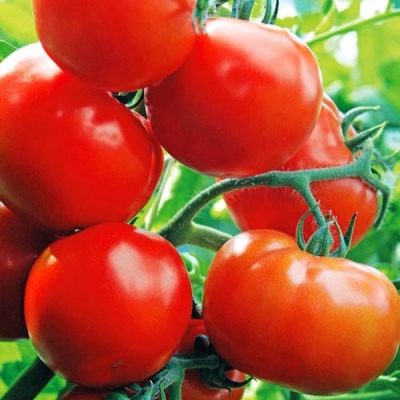
- Authors: Lukyanenko A.N., Dubinin S.V., Dubinina I.N.
- Year of approval: 2010
- Category: hybrid
- Growth type: determinant
- Appointment: fresh consumption
- Ripening period: early
- Ripening time, days: 90-95
- Growing conditions: for open ground, for closed ground
- Marketability: high
- Transportability: Yes
Every season, summer residents dilute their assortment of grown tomatoes with more and more new types. The main selection criteria are high and stable yields, stress resistance and ease of growing. It is these types of nightshade that the early ripe variety of Kupchikha tomatoes belongs to.
Breeding history
An early hybrid variety Kupchikha was developed by a group of Russian breeders in 2009. A year later (in 2010), the tomato entered the ranks of the breeding register of the Russian Federation, and was also approved for use. Recommended growing regions are all climatic zones of the country. The nightshade crop successfully grows in greenhouses, and in greenhouses, and in the beds of summer cottages.
Description of the variety
The merchant's wife is a determinant tomato of medium height, growing up to 700-800 mm. The hybrid plant has a moderate thickening with large dark green foliage, a strong central stem with fragile branches, a powerful root system and simple inflorescences. It is characterized by the type of carpal fruiting. One brush gives off 5-6 ovaries (tomatoes).
When growing a culture, it is recommended to form a bush in 1 stem, extremely rarely in 2-3 trunks, tie it to a support, otherwise fragile branches will sag and break off under the weight of weighty tomatoes. The plant does not need pinching, since the growth of new stepchildren is very slow, but it is necessary to get rid of excess foliage, since it can block the access of light to the fruits.
The main qualities of the fruit
The merchant's wife represents a class of large-fruited tomatoes. It is characterized by a flat-round shape with a slight ribbing. The tomato color is classic - bright red when ripe. In an unripe state, the tomato is green, with a light spot at the base. Giant tomatoes on average gain weight up to 200-250 grams. The vegetable peel is perfectly smooth, with clear overflows, thin but strong, well protecting the fruit from cracking. In addition, the tomato is transportable and endowed with a long shelf life: vegetables can be stored for 45 days.
Taste characteristics
Tomatoes taste great. They are sweetish, without the slightest sourness, well complemented by the aromatic spice present in many tomatoes. The flesh of the berries is fleshy, moderately dense, with a limited number of seeds, very juicy, but not watery. Due to their juiciness, tomatoes are ideal for processing into dressings, sauces.
Ripening and fruiting
The merchant's wife is an early ripe species of nightshade. From the stage of germination to a ripe tomato on the brush, 3 months pass (90-95 days). Fruiting in the culture is early and amicable, which allows you to remove tomatoes with whole fruit clusters. The return of fruits occurs in July. Sometimes tomatoes begin to sing from the end of June.
Yield
The crop yield is excellent. It is characteristic that in open ground the indicators are slightly higher than in greenhouses and greenhouse structures. Subject to all agrotechnical rules, 1 m2 gives up to 9.2 kg.
The timing of planting seedlings and planting in the ground
Sowing seeds is best done at the end of March. Germination of seedlings is carried out in a room with a temperature of + 20-22, where there is sufficient lighting for more than 14 hours a day. Glass or film will speed up the process. After 2-3 leaves have grown, a dive is carried out. 10 days before transplanting, plants need to be hardened outdoors.
Transfer to the garden is performed when the bush already has 6-7 leaves and 1 fruit cluster. The procedure is performed in the second half of the last month of spring.

Growing tomato seedlings is an extremely important process, because it largely depends on whether the gardener will be able to harvest at all. All aspects must be taken into account, from seedbed preparation to planting in the ground.
Landing scheme
The layout and density of the seedling bushes are very important in the growing process, so they should be observed. Due to the fact that tomato bushes are moderately compact, 3-4 plants can be placed per 1 m2. When disembarking, you need to follow the 50x60 cm scheme.

Growing and care
For healthy growth, seedlings need a loose, fertile and moist soil, free of weeds. The best place to grow is the soil on which cabbage or pumpkin were previously grown. Comprehensive tomato care includes regular watering, fertilizing, loosening the soil, shaping and tying a bush, as well as preventing ailments.




A plant needs different micronutrients at each stage of growth. All fertilizers can be divided into two groups: mineral and organic. Folk remedies are often used: iodine, yeast, bird droppings, eggshells.
It is important to observe the rate and period of feeding. This also applies to folk remedies and organic fertilizers.
Disease and pest resistance
The variety has high immunity. The variety is immune to fusarium wilt and verticillosis. Tomato is exposed to phytophthora only if it grows in an excessively humid environment. Timely spraying with a special solution will save from the invasion of pests.


Resistant to adverse weather conditions
The culture has excellent tolerance to stress factors: temperature fluctuations, drought, heat. The plant is negatively affected by excess air humidity, which can lead to the development of brown spot.

























































































